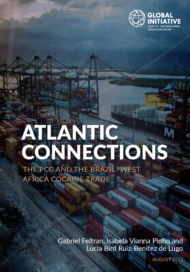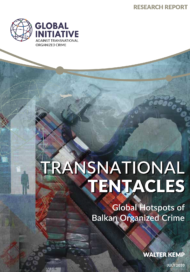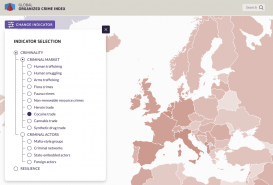Serbian national Goran Popovic, a former military ‘Red Beret’ with an international arrest warrant out against him for drug trafficking, was sitting in a small internet café in the Bolivian city of Santa Cruz de la Sierra when a hitman approached from behind and shot him in the head three times. Investigations into the murder would reveal that members of Grupo América – an organized crime group with roots in the Western Balkans that has been trafficking drugs from South America to Europe since 2008 – had been established in Bolivia for several years.
Popovic’s murder in 2014 is just one in a series of hits on criminal figures that point to the Balkan mafia’s increased presence in Latin America and hint at the extent of the transnational criminal links between the two regions. Over the past three decades, criminal groups from the Western Balkans have been growing their footprint in the region, leaving behind a trail of blood in the Americas while shipping large consignments of cocaine to Europe and beyond.
The presence of these groups in Latin America has been recorded since the late 1990s, coinciding with increased cocaine production in the region and demand for the substance, particularly in Europe. Over the last 20 years, however, they have significantly increased their involvement and influence in the international cocaine trafficking market. For years, Balkan nationals have facilitated cocaine shipments from Colombia, Ecuador, Brazil and Peru to Europe and the US. Many have been killed or arrested in South America, particularly in Ecuador, where there is a large presence of these groups given the country’s strategic location and port infrastructure.
This rise of Western Balkan groups – particularly from Albania, Serbia, Montenegro and Bosnia and Herzegovina – in the international cocaine trade can be attributed to several factors, some of which are related to the vulnerabilities of many Latin American countries. These criminal organizations have taken advantage of widespread corruption, prison crises, porous borders and lack of security in critical infrastructure such as ports, which these groups exploit to bring drugs to the European continent using various routes and methods to transport cocaine from Latin America to major ports in Europe.
Direct contact with Latin America eliminates the need for middlemen, and the profit on cocaine is 10 times greater. According to GI-TOC interviews with investigative journalists in South America and the Western Balkans, Balkan criminal groups can purchase a kilogram of cocaine in the region for between US$1500 and US$4 000, which is then sold in Western Europe for between US$30 000 and US$60 000 per kilogram.Even before setting foot in Latin America, groups from the Balkans had a long history of criminal activity, fuelled by corruption in their own countries. Wars and unrest in the region throughout the 1990s further strengthened and contributed to their criminal experience. On the other hand, their presence in key Western European countries, such as Belgium, the Netherlands and Spain, has not only extended their reach but also provided them with valuable opportunities to enhance their skills, capabilities and expertise in navigating the international criminal scene. These elements have contributed significantly to their success and growth in the cocaine market, placing them among the most prolific international criminal organizations in operation.
To identify these transnational links extending from the Balkans to Latin America, the Global Initiative Against Transnational Organized Crime (GI-TOC) and Instituto Prensa y Sociedad (IPYS) have jointly developed a new investigative journalism network.
This initiative has been set up to identify, map and report on the links between criminal groups in Latin America and the Western Balkans. Investigative journalists from countries in both regions – namely, Albania, Bosnia and Herzegovina, Serbia, Montenegro, Kosovo, North Macedonia, Ecuador, Colombia, Mexico, Peru, Bolivia and Brazil – have been trained with tools and methods to report on organized crime and the dynamics that have strengthened the involvement of these Western Balkan groups in the cocaine trade in particular. Their research looked at trends in drug prices, cases of money laundering, as well as data on cocaine seizures in the Balkans and homicides linked to drug trafficking.
As part of the project, the GI-TOC and the IPYS published a series of investigative stories in the news media in Latin America and Europe. The stories focus on individuals and criminal groups from the Balkans who are integrated into international cocaine supply chains. They employ sophisticated and effective smuggling and distribution methods that allow them to circumvent the legal system, and in some countries, they have even been able to co-opt corrupt state officials in key institutions. The collaboration has led to a deeper understanding of the relationships between these groups.
The stories shed new light on these criminal networks and open the door to future joint investigative reporting on a larger scale, highlighting the key role of civil society in adopting transnational approaches to countering organized crime.
Click here to read the stories.
Una red de periodistas latinoamericanos y balcánicos investiga los vínculos criminales entre sus regiones
El ciudadano serbio Goran Popovic, exmilitar «boina roja» y con una orden de detención internacional por tráfico de drogas, se encontraba en un pequeño cibercafé de la ciudad boliviana de Santa Cruz de la Sierra cuando un sicario se le acercó por la espalda y le disparó tres veces en la cabeza. Las investigaciones sobre el asesinato revelaron que miembros del Grupo América, un grupo de crimen organizado con raíces en los Balcanes Occidentales que trafica drogas de Sudamérica a Europa desde 2008, llevaban varios años establecidos en Bolivia.
El asesinato de Popovic en 2014 es solo uno más de una serie de golpes a figuras criminales que apuntan a la creciente presencia de la mafia balcánica en Latinoamérica e insinúan el alcance de los vínculos criminales transnacionales entre ambas regiones. En las tres últimas décadas, la presencia de grupos criminales balcánicos en la región ha ido en aumento, dejando tras de sí un rastro de sangre en el continente americano al tiempo que envian grandes cargamentos de cocaína a Europa y otras regiones del planeta.
La presencia de estos grupos en Latinoamérica se registra desde finales de la década de 1990, coincidiendo con el aumento de la producción de cocaína en la región y de la demanda de esta sustancia, sobre todo en Europa. En los últimos 20 años, sin embargo, los grupos han ampliado considerablemente su participación e influencia en el mercado internacional del tráfico de cocaína. Durante años, criminales balcánicos han facilitado envíos de cocaína desde Colombia, Ecuador, Brasil y Perú a Europa y Estados Unidos. Muchos han sido asesinados o detenidos en Sudamérica, sobre todo en Ecuador, donde tienen una gran presencia dada la situación estratégica del país y sus infraestructuras portuarias.
La implicación de grupos procedentes de los Balcanes Occidentales (sobre todo de Albania, Serbia, Montenegro y Bosnia y Herzegovina) en el comercio internacional de cocaína puede atribuirse a varios factores, algunos de los cuales están relacionados con las vulnerabilidades de muchos países latinoamericanos. Estas organizaciones criminales se han aprovechado de la corrupción generalizada, las crisis penitenciarias, la porosidad de las fronteras y la falta de seguridad en infraestructuras críticas como los puertos, que son explotados para introducir la droga en el continente europeo a través de diversas rutas desde Latinoamérica hasta los principales puertos de Europa.
El contacto directo con Latinoamérica elimina la necesidad de intermediarios, haciendo que el beneficio de la cocaína sea 10 veces mayor. Según entrevistas realizadas por GI-TOC con periodistas de investigación en Latinoamérica y los Balcanes Occidentales, los grupos criminales balcánicos pueden comprar un kilogramo de cocaína en la región por entre 1 500 y 4 000 dólares, que luego venden en Europa Occidental por entre 30 000 y 60 000 dólares.
Antes de poner pie en Latinoamérica, estos grupos balcánicos ya tenían un largo historial de actividad criminal, alimentada por la corrupción en sus propios países. Las guerras y los disturbios en la región a lo largo de la década de 1990 reforzaron y ampliaron aún más su experiencia criminal. Por otro lado, su presencia en países clave de Europa Occidental, como Bélgica, Países Bajos y España, no solo ha ampliado su alcance, sino que les ha proporcionado valiosas oportunidades para mejorar sus habilidades, capacidades y experiencia a la hora de desenvolverse en la escena criminal internacional. Estos elementos han contribuido significativamente a su éxito y crecimiento en el mercado de la cocaína, situándolos entre los grupos criminales internacionales más prolíficos de la actualidad.
Para identificar los vínculos que se extienden desde los Balcanes hasta Latinoamérica, Global Initiative Against Transnational Organized Crime (la Iniciativa global contra el crimen organizado transnacional, GI-TOC) y el Instituto Prensa y Sociedad (IPYS) han desarrollado conjuntamente una nueva red de periodismo de investigación.
Esta iniciativa ha sido creada para identificar, mapear e informar sobre los vínculos entre los grupos criminales de Latinoamérica y los Balcanes Occidentales. Periodistas de investigación de países de ambas regiones, como Albania, Bosnia y Herzegovina, Serbia, Montenegro, Kosovo, Macedonia del Norte, Ecuador, Colombia, México, Perú, Bolivia y Brasil, han recibido formación con herramientas y métodos para informar sobre el crimen organizado y las dinámicas que han permitido la implicación de estos grupos en el tráfico de cocaína. Sus investigaciones han analizado las tendencias de los precios de la droga, casos de lavado de dinero, así como datos sobre incautaciones de cocaína en los Balcanes y homicidios relacionados con el narcotráfico.
Como parte del proyecto, GI-TOC y el IPYS han publicado una serie de reportajes de investigación en medios de comunicación latinamoericanos y europeos. Los reportajes se centran en actores y grupos criminales de los Balcanes integrados en las cadenas internacionales de tráfico de cocaína, quienes emplean sofisticados métodos de contrabando y distribución que les permiten eludir el sistema legal y, en algunos países, incluso cooptar a funcionarios estatales corruptos en instituciones clave. La colaboración de GI-TOC y el IPYS ha permitido profundizar en el conocimiento de las relaciones entre estos grupos.
Los reportajes han puesto de manifiesto los largos vínculos de estas redes criminales y abren la posibilidad a futuros trabajos de investigación conjuntos a mayor escala, destacando el papel clave de la sociedad civil en la adopción de enfoques transnacionales para combatir el crimen organizado.
Haga clic aquí para leer los reportajes.



